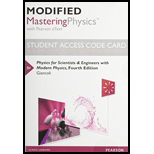
What type of bond would you expect for (a) the N2 molecule, (b) the HCl molecule, (c) Fe atoms in a solid?
(a)
Find the type of bond present in N2 molecule.
Answer to Problem 1Q
The type of bond present in N2 molecule is covalent.
Explanation of Solution
The nitrogen molecule is diatomic molecule and has five valence electrons so it needs three more valence electron to complete its octet.
Thus the nitrogen molecule will share its three electron with another nitrogen to form octet so the bonding in nitrogen molecule is covalent.
(b)
Find the type of bond present in HCl molecule.
Answer to Problem 1Q
The type of bond present in HCl molecule is ionic.
Explanation of Solution
The HCl molecule is diatomic molecule and when it is bubbled into water it ionizes completely as hydrogen ion and chlorine ion.
Even in the gases state of HCl, chlorine is partially negative and hydrogen is partially positive thus the bond in the HCl is ionic.
(c)
Find the type of bond present in Fe atom in solid.
Answer to Problem 1Q
The type of bond present in Fe atom in solid is metallic.
Explanation of Solution
The Fe atom are metal and when it present in the solid state form they form metallic bond with another metal atoms.
Thus the bonding in Fe atom in metal is metallic.
Want to see more full solutions like this?
Chapter 40 Solutions
Modified Mastering Physics with Pearson eText -- Standalone Access Card -- for Physics for Scientists & Engineers with Modern Physics
Additional Science Textbook Solutions
University Physics Volume 2
An Introduction to Thermal Physics
Glencoe Physical Science 2012 Student Edition (Glencoe Science) (McGraw-Hill Education)
Conceptual Physics (12th Edition)
Essential University Physics: Volume 2 (3rd Edition)
Physics: Principles with Applications
- The Madelung constant for the NaCl structure may be found by summing an infinite alternating series of terms giving the electrostatic potential energy between an Na+ ion and its 6 nearest Cl neighbors, its 12 next-nearest N+ neighbors, and so on (see Fig. 12.1a). (a) From this expression, show that the first three terms of the infinite series for the Madelung constant for the NaCl structure yield = 2.13. (b) Does this infinite series converge rapidly? Calculate the fourth term as a check.arrow_forwardThe CO molecule undergoes a rotational transition from the ℓ = 1 level to the ℓ = 2 level. Using Table 11.1, calculate the values of the reduced mass and the bond length of the molecule. Compare your results with those of Example 11.1.arrow_forwardThe characteristic energy for KCl is 1.4105eV . (a) Determine for the KC1 molecule, (b) Find the separation distance between the K arid Cl atoms.arrow_forward
- The equilibrium separation between the two ions in the KCl molecule is 0.267 nm. (a) Assuming that the K+ and Cl- ions are point particles, compute the electric dipole moment of the molecule. (b) Compute the ratio of your result in (a) to the measured electric dipole moment of 5.41 x 10-29 C*m. This ratio is known as the fractional ionic character of the molecular bond.arrow_forwardis the tranfer or sharing valence electrons different than bonding. If so, how?arrow_forwardThe bond length for 1H19F is 91.68 pm . Calculate rH and rF from the center of mass.arrow_forward
- Show that the moment of inertia of a diatomic molecule composed of atoms of masses mA and mB and bond length R is equal to meffR2, where meff = mAmB/(mA+mB).arrow_forwardShow that the moment of inertia of a diatomic molecule composed of atoms of masses mA and mB and bond length R is equal to meffR2, where meff = mAmB/(mA + mB).arrow_forwardSn, C, and Si, Ge are all group XIV elements. Yet, Sn is a conductor, C is an insulator while Si and Ge are semiconductors. Why?arrow_forward
- Calculate the net energy of a NaCl ion paired separated by an inter-ionic distance of 1.475 nm, If the net force between the ion pair is 6.725 x 10^-12 N. n=9 z1= +1 z2= -1arrow_forwardThe figure above shows the absorption spectrum of the molecule HBr. Following the basic procedures of Section 9.6, find:(a) the energy of the “missing” transition;(b) the effective force constant k;(c) the rotational spacing 2B. Estimate the value of the rotational spacing expected for HBr and compare with the value deduced from the spectrum. Why are there only single lines and not double lines as in the case of HCl?arrow_forwardThe bond length in the BrF molecule is 178 pm and the measured dipole moment is 1.29 D (debyes). What is the magnitude of the negative charge (in units of the electronic charge e) on F in BrF? (1 debye = 3.34 × 10−30 coulomb-meters; electronic charge = e = 1.6 × 10−19 coulombs). A. 0.15 B. 0.24 C. 0.33 D. 1.00 E. 1.6 × 10−19arrow_forward
 Modern PhysicsPhysicsISBN:9781111794378Author:Raymond A. Serway, Clement J. Moses, Curt A. MoyerPublisher:Cengage Learning
Modern PhysicsPhysicsISBN:9781111794378Author:Raymond A. Serway, Clement J. Moses, Curt A. MoyerPublisher:Cengage Learning University Physics Volume 3PhysicsISBN:9781938168185Author:William Moebs, Jeff SannyPublisher:OpenStax
University Physics Volume 3PhysicsISBN:9781938168185Author:William Moebs, Jeff SannyPublisher:OpenStax Glencoe Physics: Principles and Problems, Student...PhysicsISBN:9780078807213Author:Paul W. ZitzewitzPublisher:Glencoe/McGraw-Hill
Glencoe Physics: Principles and Problems, Student...PhysicsISBN:9780078807213Author:Paul W. ZitzewitzPublisher:Glencoe/McGraw-Hill Physics for Scientists and Engineers with Modern ...PhysicsISBN:9781337553292Author:Raymond A. Serway, John W. JewettPublisher:Cengage Learning
Physics for Scientists and Engineers with Modern ...PhysicsISBN:9781337553292Author:Raymond A. Serway, John W. JewettPublisher:Cengage Learning




